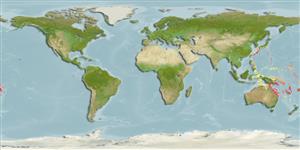Actinopterygii (ray-finned fishes) >
Syngnathiformes (Pipefishes and seahorses) >
Syngnathidae (Pipefishes and seahorses) > Hippocampinae
Etymology: Hippocampus: Greek, ippos = horse + Greek,kampe = curvature (Ref. 45335); hendriki: Named for Hendrik Kuiter in recognition of his keen interest in seahorses that he successfully conveyed to classmates and teachers.
Issue
This species is a synonym of Hippocampus angustus Günther, 1870 according to Lourie et al., 2016 (Ref. 115213). This species record will be removed.
Environment / Climate / Range
Ecology
Marine; demersal; non-migratory; depth range 16 - 25 m (Ref. 42735). Tropical, preferred ?
Western Central Pacific: Queensland, Australia. International trade is monitored through a licensing system (CITES II, since 5.15.04) and a minimum size of 10 cm applies.
Size / Weight / Age
Maturity: Lm ? range ? - ? cm
Max length : 10.4 cm OT (female)
Short description
Morphology | Morphometrics
Dorsal
spines
(total): 0;
Dorsal
soft rays
(total): 17-18. Trunk rings 11; tail rings 34; subdorsal spines 3/0,1,0; nose spine of moderate length, angular in shape; spine above eye long, but shorter than eye diameter; spine behind eye of moderate size, followed by longer lateral head spine; coronet moderately high, sloping back in line with head profile; superior trunk ridge spines reduced to tubercles before dorsal fin in males, or entire ridge having irregular rugose parts with small spines on and in between junctions with rings (Ref. 42735).
Occurs over soft bottom of the continental shelf (Ref. 75154). Maximum length is based on a straight-line length measurement from upper surface (ignoring spines) of first trunk ring, to tip of tail (Ref. 42735). Ovoviviparous (Ref. 205). The male carries the eggs in a brood pouch which is found under the tail (Ref. 205). Minimum depth from Ref. 58018.
Life cycle and mating behavior
Maturity | Reproduction | Spawning | Eggs | Fecundity | Larvae
Male carries the eggs in a brood pouch (Ref. 205).
Kuiter, R.H., 2001. Revision of the Australian seahorses of the genus Hippocampus (Syngnathiformes: Syngnathidae) with descriptions of nine new species. Rec. Aus. Mus. 53:293-340. (Ref. 42735)
IUCN Red List Status (Ref. 115185)
Threat to humans
Harmless
Human uses
More information
Age/SizeGrowthLength-weightLength-lengthLength-frequenciesMorphometricsMorphologyLarvaeLarval dynamicsRecruitmentAbundance
ReferencesAquacultureAquaculture profileStrainsGeneticsAllele frequenciesHeritabilityDiseasesProcessingMass conversion
Tools
Special reports
Download XML
Internet sources
